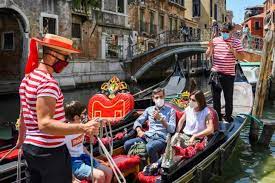Italy welcomes back its long-lost tourists

Rome: As Italy reopens to tourism, we look at what tourists can expect when they return to the ‘Bel paese’.
Italy is starting to welcome back its tourists, a trickle for now but that is set to change soon as the five-day quarantine restrictions are lifted for visitors from the EU and Schengen countries, the UK and Israel.
This quarantine requirement for tourists from these countries will be dropped from 16 May however a negative coronavirus test result will still be required before travelling to Italy.
In early May the Italian premier Mario Draghi invited tourists to book their summer holidays in Italy, stating that the country would be open to visitors who have been vaccinated, have just tested negative or can prove they have recently recovered from covid-19.
“The world wants to travel to Italy” – the prime minister said – “the pandemic has forced us to close but Italy is ready to welcome back the world.”
Italy to reopen for tourists this summer
An upbeat Draghi added: “The time has come to book your holidays in Italy – our mountains, our beaches, our cities are reopening.”
The move comes as the health ministry announced on 14 May that more than eight million people in Italy are fully vaccinated against covid-19, with almost 26 million covid shots administered to date.
The virus has not gone away, far from it, however the head of Italy’s Higher Health Institute (ISS) Silvio Brusaferro said on 14 May that the nation’s contagion curve was “gradually declining,” with the incidence of covid infections falling to 96 cases for every 100,000 inhabitants.
“It is a slow decline but one that has continued for several weeks and can seen in all of the regions,” said Brusaferro.
Italy is now emerging slowly from a year spent grappling with lockdowns and extended closures, with things finally opening up again, for both Italians and tourists.
The country is still operating under a system of tiered covid-19 restrictions, with regions divided into colours based on the level of risk of infections.
From 17 May almost all of Italy (except Val d’Aosta) will be classified as the lower-risk ‘yellow’ zone, with less stringent rules applying.
This includes Italy’s major cities – Rome, Milan, Florence, Naples and Venice – however bear in mind that the colours can change on a regular basis, depending on the epidemiological situation.
In tandem with its efforts to vaccinate the population as quickly as possible, Italy is desperate to kickstart its battered tourism sector which in pre-covid times generated some 13 per cent of the country’s economic output.
So what should tourists expect in Italy and how have things changed since covid-19 turned the country’s crucial tourism and hospitality sectors upside down?
The most noticeable thing – for returning tourists – is that they will have museums and landmark sites almost to themselves – although this phenomenon is not likely to last long!
Venues with limited space have expanded onto pavements outside or set up decking areas on the street. Many restaurants have extended their opening hours – late lunches and early dinners – due to the early closure obliged by the curfew.
For now, rain is the biggest fear of restaurant owners but thankfully summer is on its way. However remember to pack layers as the evenings are still quite cool for outdoor dining.
Many bars are currently waiving their usual “outside” (higher) prices until business goes back to normal and customers can once again dine indoors – again, expect news on that front soon.
It is no longer possible to just walk into a museum or queue up to buy a ticket at archaeological sites – everything has moved online, with visitors obliged to book their tickets in advance. In the case of the bigger museums and at weekends, it is advised to book at least a day before visiting.
Cinema and theatres have reopened, with limited numbers and strict covid-19 protocols, and outdoor festivals and concerts can take place with reduced numbers and social distancing rules.
On the subway, buses and trams, there are seats marked off-limits, with capacity capped at 50 per cent. There are ‘covid-free’ trains running between Milan and the capital, with passengers tested before boarding. In Rome commuters are obliged to enter buses from the front and exit at the back.
Italy’s beaches, beach clubs and outdoor swimming pools reopen from 15 May, with covid protocols in place.





